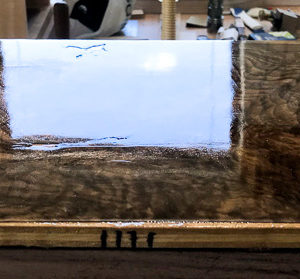Greetings,
I would like to hear from those of you who have some experience filling pores and fissures with pure shellac.
For the sake of clarity, I have tried several commercial pore fillers that are advertised to dry clear. My experience has determined that all of these pore fillers leave gray residue in the pores. (I use a 10x loupe for this.) Not what I want.
Nearly all of my work is surfaced with walnut veneer. I am aware that using 4F pumice to scrub the surface with to fill pores is historically common practice. This method, once again, leave the pores filled with the gray pumice residue. This method works well with lighter colored stock, but not for walnut veneer.
The downside to using pure shellac is the time involved in achieving a pore-free surface. Using heavier cuts than 1-LB has not, in my experience, helped in any way because heavy cuts take much longer to thoroughly dry. A dry surface is no guarantee of actual dryness within the shellac film.
I’ve attached a test board for your perusal.
All comments and suggestions are most welcome.
Thanks,
Phillip

















Replies
Phillip,
Not sure what you are trying to achieve.
"Filling" wood pores is generally done with a filler tinted to at least the general wood color or (more usually), darker. Filler is also used without any tint color, in which case it is transparent under the final finish, despite the fact that it may look like a gray residue at the end of the filling stage itself.
If you do not want the filler imparting any color to the final look of your work, use it untinted. I don't think you'll see a grey look to the pores when the finish has been applied and brought to its final luster. Or use a medium tint matching the wood and the filler won't bring attention to itself.
It's not usual to try to fill pores with shellac alone. It can be done, but the result is much more tedious than using a pore filler and achieves no better result. To use shellac in this way requires many, many very dilute applications and leveling, not a heavy cut.
Shellac and pumice are the ingredients to use in the first steps of French polishing. But this does not just leave pumice in the pores. The process creates a slurry of pumice, shellac and wood particles as fine as the pumice, filling the pores with that mixture, which of course is the general color of the wood being worked.
It's a tedious and traditional method that gives beautiful results in the hands of someone who has acquired the skill. But Behlen's Por-O-Pac pore filler or similar products, tinted as desired, and applied per the manufacturer's directions give results every bit as good.
Rich
I've never filled walnut veneer but have used a water thinned Timbermate product on walnut lumber and it works well. It does not leave a gray residue but the color may be off once it dries and before finishing although in my experience it takes finish well without any tell tale signs.
I left you a fairly in-depth reply, but it vanished for some reason. I will try again later.
Note!
Yesterday I received an email notice from this forum as follows:
"Phillip, Not sure what you are trying to achieve. "Filling" wood pores is generally done with a filler tinted to at least the general wood color or (more usually), darker. Filler is also used without any tint color, in which case it is transparent under the final finish, despite the..."
Where this post is I have no idea. Regardless, thanks for your post.
Thanks for sharing your experience with Timbermate.
While doing research on this product and reading all the comments on pore fillers I have come to the following conclusion: All water and alcohol based pore fillers contract after the carrier fluid evaporates. This should shock no one, but this is the inherent problem with these types of pore fillers.
That said, I also came across Solarez’s ‘I can’t believe it’s not lacquer’ grain sealer. This product is applied and then removed with a squeegee or plastic card. The piece is then moved out into sunlight whereby UV fully cures this finish in 3-5 minutes dependent on the intensity of the UV. When dry it is claimed that the finish shrinks minimally compared to other pore fillers.
If this product does in fact dry clear and contracts very little when dry, then this could be the perfect pore filler for my needs. More importantly, waiting 3-5 minutes for the finish to fully cure is superior to having to wait days.
I have read nothing about applying shellac over this, but after I try it I will know more.
Thanks again for your comments because this led me this product which could be the pore filling solution I have been seeking.
Not sure if you are filling before or after gluing the veneer. I seal the exposed face of porous veneers with 2-3 coats of de-waxed blond shellac prior to glue-up. The shellac is probably about a 2-3lb cut equivalent (I work on the basis that it looks about the right consistency) applied generously with a brush. After glue-up I use an orbital sander to remove excess and ridges prior to building up the final finish. Any minimal epoxy bleed through is on top of the thick shellac and pores are filled.
I have not experienced anything to suggest the shellac is not dry right through. I live in a low humidity environment.
I used a commercial filler once, never again.
Hello PhillipB
Shellac shrinks---as do all solvent based products---and it goes on shrinking for a long time---you ask me how I know! Since I French polish my classical guitars, and love shellac, I've tried using it as a pore fill and defect repair, and have given up on it.
Solarez UV Grain Sealer looks promising, and I'm starting tests this weekend. It cures with exposure to a few minutes of sunlight, and is the favorite of electric guitar builder Chris Monck of Hiline Guitars.
Cheers,
Brian
This forum post is now archived. Commenting has been disabled